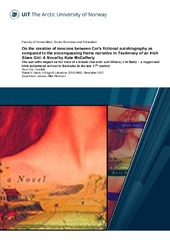| dc.description.abstract | The thesis discusses Kate McCafferty’s novel Testimony of an Irish Slave Girl from 2003, in which the Irish heroine is Cot Daley, an indentured servant, who lives in Barbados in the seventeenth century. The thesis focuses upon how the novel negotiates the relationship between the historical contexts and the novel’s plot, theme and norm, and – moreover – how McCafferty’s Testimony negotiates the tension between a testimony that is told as a life-story monologue and the interruptions that the novel’s frame narrative imposes on the main character’s monologue. The monologue dominates the novel in terms of pages, but it will be suggested that the frame narrative is likely to channel a reader’s interest in other directions. To exaggerate, one might even argue that the frame narrative may be seen as disturbing and at times as destroying the content or coherence of the main character’s monologue. However, in addition or alternatively, the frame narrative might also function in a better way – among others as a mirror or a resonance to the framed narrative, the life-story monologue. Thus, the repressions that Cot Quashey tells about in her narrative are supported or echoed in the frame narrative – including her six days of interrogation and her execution.
<p>In terms of organization, the thesis begins with a short description and summary of the novel Testimony of an Irish Slave Girl and its main plot, themes, and historical context, as well as its generic placement as a “historical novel”. It will then define, explore, and examine significant structural components of the narrative, specifically frame stories, analepsis and prolepsis, and focalization, before moving more broadly into an introspective discussion of the narrative’s impact. | en_US |


 English
English norsk
norsk
